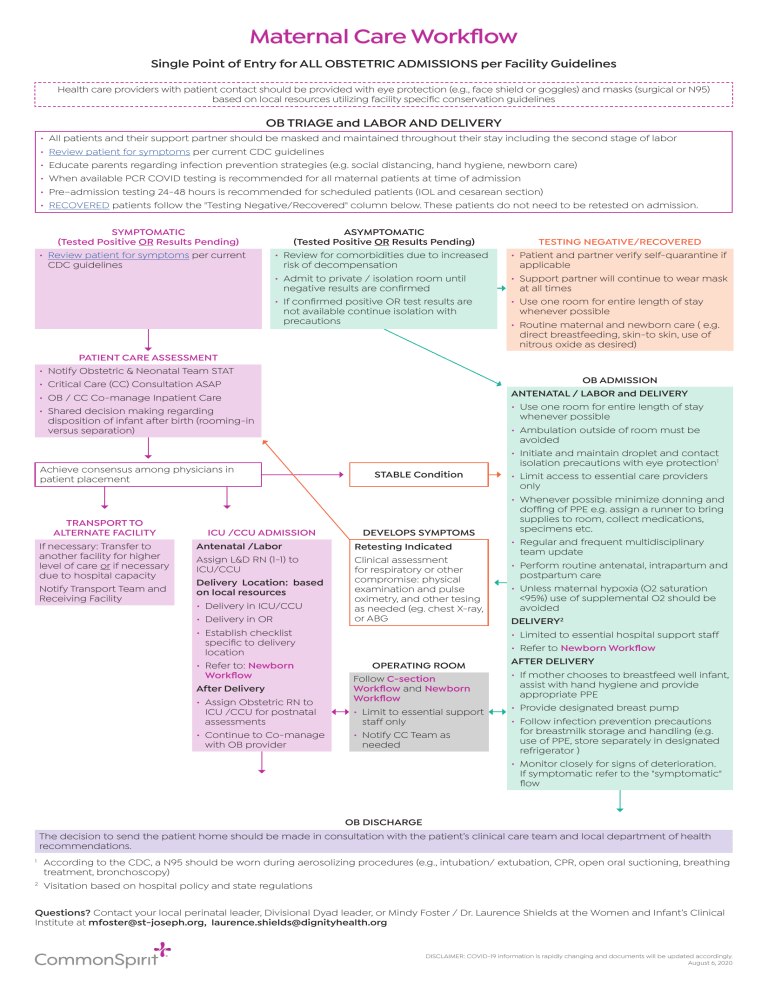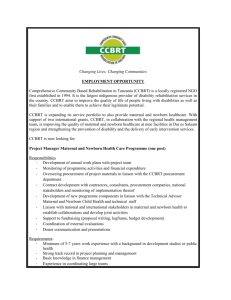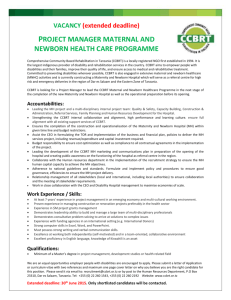
Maternal Care Workflow Single Point of Entry for ALL OBSTETRIC ADMISSIONS per Facility Guidelines Health care providers with patient contact should be provided with eye protection (e.g., face shield or goggles) and masks (surgical or N95) based on local resources utilizing facility specific conservation guidelines OB TRIAGE and LABOR AND DELIVERY • • • • • • All patients and their support partner should be masked and maintained throughout their stay including the second stage of labor Review patient for symptoms per current CDC guidelines Educate parents regarding infection prevention strategies (e.g. social distancing, hand hygiene, newborn care) When available PCR COVID testing is recommended for all maternal patients at time of admission Pre–admission testing 24-48 hours is recommended for scheduled patients (IOL and cesarean section) RECOVERED patients follow the "Testing Negative/Recovered" column below. These patients do not need to be retested on admission. SYMPTOMATIC (Tested Positive OR Results Pending) • Review patient for symptoms per current CDC guidelines • • • • ASYMPTOMATIC (Tested Positive OR Results Pending) • Review for comorbidities due to increased risk of decompensation • Admit to private / isolation room until negative results are confirmed • If confirmed positive OR test results are not available continue isolation with precautions PATIENT CARE ASSESSMENT Notify Obstetric & Neonatal Team STAT Critical Care (CC) Consultation ASAP OB / CC Co-manage Inpatient Care Shared decision making regarding disposition of infant after birth (rooming-in versus separation) Achieve consensus among physicians in patient placement TRANSPORT TO ALTERNATE FACILITY If necessary: Transfer to another facility for higher level of care or if necessary due to hospital capacity Notify Transport Team and Receiving Facility TESTING NEGATIVE/RECOVERED • Patient and partner verify self-quarantine if applicable • Support partner will continue to wear mask at all times • Use one room for entire length of stay whenever possible • Routine maternal and newborn care ( e.g. direct breastfeeding, skin-to skin, use of nitrous oxide as desired) OB ADMISSION STABLE Condition ICU /CCU ADMISSION DEVELOPS SYMPTOMS Antenatal /Labor Assign L&D RN (1-1) to ICU/CCU Delivery Location: based on local resources • Delivery in ICU/CCU • Delivery in OR • Establish checklist specific to delivery location • Refer to: Newborn Workflow After Delivery • Assign Obstetric RN to ICU /CCU for postnatal assessments • Continue to Co-manage with OB provider Retesting Indicated Clinical assessment for respiratory or other compromise: physical examination and pulse oximetry, and other tesing as needed (eg. chest X-ray, or ABG OPERATING ROOM Follow C-section Workflow and Newborn Workflow • Limit to essential support staff only • Notify CC Team as needed ANTENATAL / LABOR and DELIVERY • Use one room for entire length of stay whenever possible • Ambulation outside of room must be avoided • Initiate and maintain droplet and contact isolation precautions with eye protection1 • Limit access to essential care providers only • Whenever possible minimize donning and doffing of PPE e.g. assign a runner to bring supplies to room, collect medications, specimens etc. • Regular and frequent multidisciplinary team update • Perform routine antenatal, intrapartum and postpartum care • Unless maternal hypoxia (O2 saturation <95%) use of supplemental O2 should be avoided DELIVERY2 • Limited to essential hospital support staff • Refer to Newborn Workflow AFTER DELIVERY • If mother chooses to breastfeed well infant, assist with hand hygiene and provide appropriate PPE • Provide designated breast pump • Follow infection prevention precautions for breastmilk storage and handling (e.g. use of PPE, store separately in designated refrigerator ) • Monitor closely for signs of deterioration. If symptomatic refer to the "symptomatic" flow OB DISCHARGE The decision to send the patient home should be made in consultation with the patient’s clinical care team and local department of health recommendations. 1 2 According to the CDC, a N95 should be worn during aerosolizing procedures (e.g., intubation/ extubation, CPR, open oral suctioning, breathing treatment, bronchoscopy) Visitation based on hospital policy and state regulations Questions? Contact your local perinatal leader, Divisional Dyad leader, or Mindy Foster / Dr. Laurence Shields at the Women and Infant’s Clinical Institute at mfoster@st-joseph.org, laurence.shields@dignityhealth.org DISCLAIMER: COVID-19 information is rapidly changing and documents will be updated accordingly. August 6, 2020





